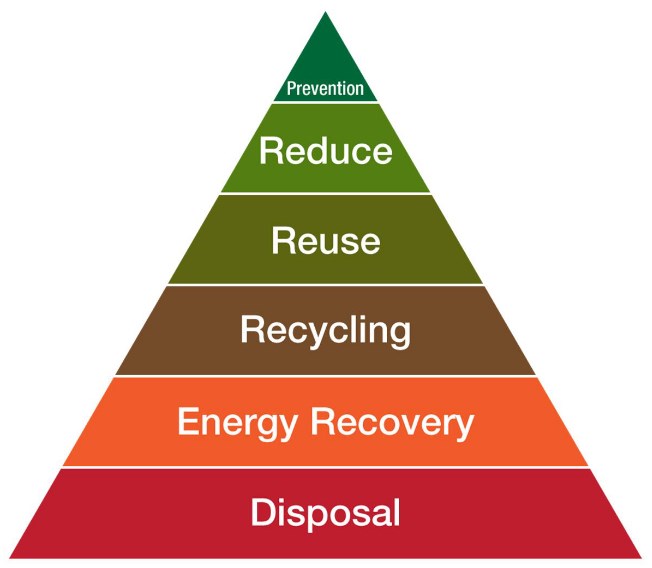Implementing the waste hierarchy pyramid in the textile industry can reduce climate change by reducing textile waste.
 Sending textiles to landfills or energy recovery facilities releases greenhouse gasses into the atmosphere. As a result, this action contributes to climate change. The US EPA estimates that the average American throws away over 80 pounds of textiles annually. However, reusing, recovering or recycling textiles removes them from the waste stream, extends their life, and serves as raw material for the development of new items. This blog article explains how the textile industry is using and implementing the waste hierarchy pyramid effectively.
Sending textiles to landfills or energy recovery facilities releases greenhouse gasses into the atmosphere. As a result, this action contributes to climate change. The US EPA estimates that the average American throws away over 80 pounds of textiles annually. However, reusing, recovering or recycling textiles removes them from the waste stream, extends their life, and serves as raw material for the development of new items. This blog article explains how the textile industry is using and implementing the waste hierarchy pyramid effectively.
What is the waste hierarchy pyramid?
Per the EU, the waste hierarchy pyramid is a set of 5 or 6 priorities for the efficient use of resources. Waste PREVENTION is at the top of the pyramid and is the preferred option. Subsequent steps include reduce (minimization), reuse, recycle, energy recovery and finally safe disposal, which sits at the bottom of the pyramid.
Within the apparel industry, there are new business models, products and ideas that demonstrate the reduce, reuse and recycle steps of the tool.
Reduce
I interpret REDUCE as buying and selling fewer new clothes or making them in a way that uses less resources.
In manufacturing, zero waste patterns increase fabric yield and minimize scraps. Waterless denim finishing, low impact dyes and fabric dyeing in the absence of water, or significantly less water, are becoming more common.
Reuse
I have written extensively on the New Textiles Economy, a white paper authored by the Ellen MacArthur Foundation because it contains excellent examples of reuse, specifically different ways to reuse clothes and improve clothing utilization.
Reuse of apparel includes the following strategies:
- Swapping, giving away to friends or donating to Goodwill, the Salvation Army or other organizations.
- Reselling first quality clothes. The RealReal sells fully authenticated secondhand luxury clothing and Poshmark, a social commerce marketplace, allows people to buy and sell new or used clothing, shoes, and accessories.
- Renting textiles. REI rents gear and clothing and Coyuchi, a home furnishings company leases sheets and towels.
- Repair clothes. Why throw something away if it can be repaired? There are numerous examples of companies repairing gently damaged articles, including Patagonia Worn Wear.
- Repurposing imperfect clothes, returned clothes or deadstock into new items. Eileen Fisher Renew take-back program and the Renewal Workshop both repurpose products into new items.
Recycle
I interpret this as fiber-to-fiber textile recycling, which must be more effectively implemented to prevent so many textiles being thrown away. Textiles that are too damaged to be worn should be recycled into new fibers. Unfortunately, many are simply down cycled into wipes or blankets, or worse yet, thrown away. However, a new NGO called Accelerating Circularity is committed to reducing the millions of tons of textile waste from entering landfills by establishing a systems approach to waste reduction.
Textiles can be mechanically recycled or chemically recycled and there are pros and cons of both. Even though chemical recycling is in its infancy in the apparel industry, there are rays of hope, shown by the success and commercialization of Re:Newcell and Worn Again Technologies.
Energy Recovery (waste to energy)
The penultimate step of the waste hierarchy pyramid is energy recovery from combustion.
“Waste-to-energy” generates energy from the treatment of waste, or the processing of waste into a fuel source. Methane, ethane or ethanol are common outputs of this process.
The final step in the pyramid is the safe DISPOSAL of textiles, which ideally, should not occur at all. Textiles should always have a second life, or a third or a fourth!
Do you need help with your sustainability strategy?
For help with sustainability, circularity and chemicals, contact Amanda Cattermole at (415) 412 8406 or Amanda@cattermoleconsulting.com. We can help you develop powerful solutions to protect your company and brand reputation.
Tips and Insights contains information to help you make informed sustainability decisions. Each post highlights a particular topic and includes questions you may want to consider for your business.

